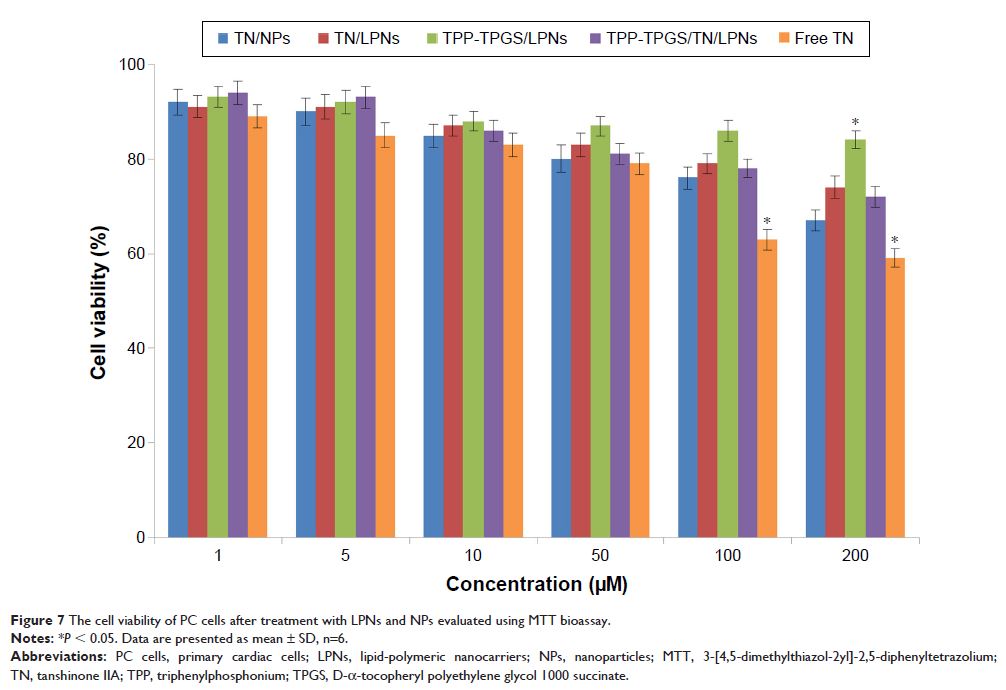9 0 6 7 6
论文已发表
注册即可获取德孚的最新动态
IF 收录期刊
- 2.6 Breast Cancer (Dove Med Press)
- 3.9 Clin Epidemiol
- 3.3 Cancer Manag Res
- 3.9 Infect Drug Resist
- 3.6 Clin Interv Aging
- 4.8 Drug Des Dev Ther
- 2.8 Int J Chronic Obstr
- 8.0 Int J Nanomed
- 2.3 Int J Women's Health
- 3.2 Neuropsych Dis Treat
- 4.0 OncoTargets Ther
- 2.2 Patient Prefer Adher
- 2.8 Ther Clin Risk Manag
- 2.7 J Pain Res
- 3.3 Diabet Metab Synd Ob
- 4.3 Psychol Res Behav Ma
- 3.4 Nat Sci Sleep
- 1.9 Pharmgenomics Pers Med
- 3.5 Risk Manag Healthc Policy
- 4.5 J Inflamm Res
- 2.3 Int J Gen Med
- 4.1 J Hepatocell Carcinoma
- 3.2 J Asthma Allergy
- 2.3 Clin Cosmet Investig Dermatol
- 3.3 J Multidiscip Healthc

三苯基鏻和 D-α-生育酚聚乙二醇 1000 琥珀酸酯修饰的加载丹参酮 IIA 的脂质聚合物纳米载体用于心肌梗死的靶向治疗
Authors Zhang S, Li J, Hu S, Wu F, Zhang X
Received 14 February 2018
Accepted for publication 7 May 2018
Published 10 July 2018 Volume 2018:13 Pages 4045—4057
DOI https://doi.org/10.2147/IJN.S165590
Checked for plagiarism Yes
Review by Single-blind
Peer reviewers approved by Dr Cristina Weinberg
Peer reviewer comments 2
Editor who approved publication: Dr Linlin Sun
Background: Cardiovascular
diseases (CVDs) are the leading causes of mortality worldwide. Currently, the
best treatment options for myocardial infarction focus on the restoration of blood
flow as soon as possible, which include reperfusion therapy, percutaneous
coronary intervention, and therapeutic thrombolytic drugs.
Materials and
methods: In the present study, we report the
development of lipid-polymeric nanocarriers (LPNs) for mitochondria-targeted
delivery of tanshinone IIA (TN). D-α-tocopheryl polyethylene glycol 1000
succinate (TPGS) was linked to the triphenylphosphonium (TPP) cation. The LPNs
were fabricated by nanoprecipitation method. LPNs were evaluated in vitro and
in vivo in comparison with free drugs and other similar nanocarriers.
Results: The mean diameter of TN/nanoparticles (NPs) was 89.6 nm, while
that of TN/LPNs was 121.3 nm. The zeta potential of TN/NPs and TN/LPNs was
–33.6 and –22.3 mV, respectively. Compared with free TN and TN/NPs, TN/LPNs
exhibited significantly improved compatibility and therapeutic efficiency. In
addition, the in vivo pharmacokinetics, biodistribution, and infarct therapy
studies in Sprague Dawley rats showed that TPP-TPGS/TN/LPNs had better efficiency
than their nonmodified TN/LPNs counterparts in all respects.
Conclusion: These results indicated that the TPP-TPGS/TN/LPNs were promising
nanocarriers for efficient delivery of cardiovascular drugs and other
therapeutic agents for the treatment of CVDs.
Keywords: myocardial infarction, mitochondria targeting, lipid-polymeric
nanocarriers, D-α-tocopheryl polyethylene glycol 1000 succinate,
triphenylphosphonium, tanshinone IIA
